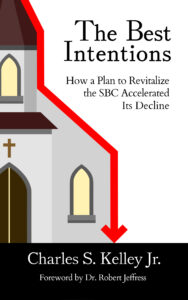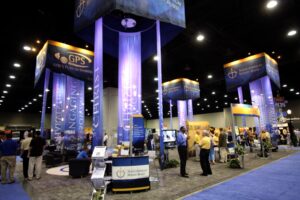EDITOR’S NOTE — Stories like the one you will read below are always difficult to develop and publish. They are difficult for two reasons.
One, because of the sheer volume of research it requires. We tip our hat to retired Baptist Press editor Art Toalston who did the work on this particular report on his own time as “a matter of Baptist journalistic integrity in our reporting of bona fide news.”
Two, because the tone and presentation will be interpreted based on the reader and his or her involvement, prior understanding and sympathies (or frustrations) toward the topic and/or group involved.
The details presented are technically straightforward and not meant to be personal attacks in any form but rather merely factual information about the topic.
Still, some will read it as endorsement and others, indictment.
I’m confident that you as consistent readers of a state Baptist newspaper (whether the print or digital format) will be able to consume it as intended. We need your help to assist others who might be tempted to use it as a weapon, however. That’s truly not our intent.
It’s important for your state Baptist newspaper to keep you aware of happenings within the denomination and help provide the necessary context for you to fully understand the implications.
Thank you in advance for approaching the story as one of information sharing, not as an advocacy or attack piece.
You are an important part of our Southern Baptist family, and you deserve to have the facts presented in full as well as with compassion and grace so you can work through and pray through how best to respond.
—Jennifer Davis Rash, editor-in-chief of The Baptist Paper
Purpose of the special report
The special report provides context for the upcoming presentation by the Great Commission Resurgence Evaluation Task Force at the 2024 annual meeting in Indianapolis.
It also studies retired seminary president Chuck Kelley’s assessment of Southern Baptist missions in North America in his 2023 book, “The Best Intentions: How a Plan to Revitalize the SBC Accelerated Its Decline.”
At issue is the revamping of the convention’s North American Mission Board set forth by a 2009 task force and adopted in 2010.
Toalston, who served with BP from 1992 to 2015, also deals with numerous other elements regarding the future of home missions, including the longstanding Cooperative Program channel by which Southern Baptists churches support missions and ministry internationally, nationally and in their states.
Toalston’s full report, spanning more than 9,000 words, includes comments, opinions and information from a broad range of SBC leaders, including Kelley, Kevin Ezell, Bart Barber, Danny Akin, Al Mohler, J.D. Greear, Ronnie Floyd, Scott McConnell, Morris Chapman, David Hankins, Johnny Hunt, Geoff Hammond, David Dockery, Amy Whitfield, Trevin Wax, Jeff Iorg, Jerry Rankin and Jim Elliff. The full report can be found on Toalston’s personal website here.
Toalston also notes that the introductory words of the 2010 Great Commission Task Force recommendations to the SBC remain applicable in 2024:
“In every generation, Southern Baptists have been called to reclaim our identity as a Great Commission movement of churches. Now is the time for this generation to answer the same call. … A world of lostness is waiting — what are we waiting for?”
A six-member task force and a retired seminary president are focal points of a current evaluation of Southern Baptist missions in North America.
The Great Commission Resurgence Evaluation Task Force appointed by SBC President Bart Barber will relay its evaluation at the 2024 annual meeting in Indianapolis.
The seminary president, Chuck Kelley, who led New Orleans Baptist Theological Seminary for 23 years, already has delivered his assessment in a 2023 book, “The Best Intentions: How a Plan to Revitalize the SBC Accelerated Its Decline.”
2010 revamping of NAMB
At issue is a 2010 revamping of the convention’s North American Mission Board set forth by a 23-member Great Commission Task Force (also called the Great Commission Resurgence Task Force) and adopted at that year’s annual meeting in Orlando, Florida.
The focus of the task force’s work was to share “how Southern Baptists can work more faithfully and effectively together in serving Christ through the Great Commission.”
Its seven components included a call for NAMB to be “unleashed” for church planting as its primary emphasis, with the mission board subsequently reallocating an estimated $50 million yearly to help fund the initiative.
That shift meant the cessation of Cooperative Agreements between NAMB and state conventions that had linked their evangelism, church planting and other ministries for 50-plus years. It’s a historic juncture “in the SBC story” of Baptist leaders “changing Baptist polity,” Kelley writes.
Especially for smaller state conventions with limited budgets in the Northeast, Midwest, Great Plains and the West, the Cooperative Agreements were the lifeblood of funding for their evangelism and church planting efforts, including various staff members and directors of missions for Baptist associations across their states.

Kelley, in his book, looked at published data about Southern Baptist church planting and baptisms from 2011 to 2021 and concluded, “No other decade in SBC history has seen such a broad statistical decline in the standard measures applied to SBC churches, including the decade of the Great Depression and the decade of the tumultuous sixties.”
More church planters needed
NAMB officials periodically have defended the statistical drops as being a difference in how the numbers were reported prior to the GCR changes, which began in 2011.
NAMB also, according to its website, has planted 10,000 churches since the 2010–2011 start of GCR, though falling 5,000 short of the 15,000 goal it placed before Southern Baptists to keep pace with yearly population growth and the loss of churches by closure or other reasons.
“Unfortunately,” NAMB President Kevin Ezell stated in the mission board’s 2018 report in the SBC Annual, “there are currently not enough qualified church planters to meet the demand.”
Ezell also reported in 2020 and 2023 that “our need for new churches is outpacing the supply of qualified church planters.”
‘Grateful’ for ‘reaffirmed commitment’
A recent statement provided for this report by a NAMB spokesperson says, “When messengers at the 2010 SBC Annual Meeting overwhelmingly approved recommendations from the Great Commission Resurgence Task Force, Southern Baptists reaffirmed their commitment to dedicating resources and efforts at every level of Baptist life to fulfilling the Great Commission. We are grateful for that commitment.
“NAMB has worked diligently to carry out the goals articulated in those recommendations, consistent with our ministry assignments and ministry objectives. We will defer further comment to allow the GCR Evaluation Task Force to do its work and share its report at the 2024 annual meeting.”
Evaluation task force
The six members of the evaluation task force were named following the 2023 annual meeting in New Orleans. The SBC’s 2023–2024 first vice president, Jay Adkins, pastor of the New Orleans-area First Baptist Church Westwego serves as chair.
The task force was created in response to a motion by Ohio pastor Randy Chestnut to study “the impact that the adopted recommendations from the (2010) Great Commission Resurgence Report … have had on (1) the effectiveness of our North American gospel mission effort and (2) the impact on relationships between SBC ministry partners.”
The motion called for the new task force to represent “all SBC partners serving from all regions of North America” and to include “any recommendations to enhance and unify our cooperative mission effort to penetrate darkness in North America.”
Barber said in a Baptist Press report that he has asked the task force “to conduct a dispassionate and fair review” that will “bring important insights to the messengers for consideration in Indianapolis.”
Adkins told BP the task force will be as “thorough” as possible given the short time frame and the fact the 2009–2010 GCR task force proceedings are sealed until 2025.
Opposing views
“GCR supporters,” Trevin Wax, then a Tennessee church’s associate pastor, wrote in a 2010 Christianity Today blog, “have sometimes spoken as if (it) will be the spark of a worldwide revival that will send renewal through the SBC.”
“GCR detractors,” Wax continued on the day of the convention’s June 2010 vote, “have sometimes spoken as if (it) would end the SBC as we know it and destroy all our cooperative efforts.” Wax currently is NAMB’s vice president for research and resource development.
Requests for comment were sent to two seminary presidents who played key roles in voicing vision for GCR and subsequently served on the 2010–2011 task force: Danny Akin of Southeastern Baptist Theological Seminary in North Carolina and R. Albert Mohler Jr. of Southern Baptist Theological Seminary in Kentucky.
Mohler, who made the motion at the 2009 annual meeting to create the task force, did not respond to two queries for comment emailed on Oct. 31 and Nov. 27.
‘Rally cry’
Akin responded, “I think changes were needed, the recommendations were sound and there has not been enough time to accurately assess the impact. … The trajectory, though slow, is moving in the right direction.”
It was Akin who sparked widespread interest across the SBC in the GCR debate, partly from his characterization of state conventions as “bloated bureaucracies.”
His April 2009 “Axioms of a Great Commission Resurgence” seminary chapel address revolved around 12 one-sentence statements of resolve to pursue the Great Commission with a heightened sense of gospel purpose.
“The rally cry of the Conservative Resurgence was, ‘We will not give our monies to liberal institutions,’” Akin said. “Now the cry of the Great Commission Resurgence is, ‘We will not give our money to bloated bureaucracies.’”
State conventions on GCR
Many state convention executive directors and associational directors of missions took issue with Akin’s slam on their areas of ministry.
Reports from 2009 highlight David Hankins, then-executive director of the Louisiana Baptist Convention.
State conventions have “a coordinated presence in every region,” he said. “We are in the churches. We know the pastors. We promote the denomination and raise the money,” Hankins said, noting they receive Cooperative Program funds from the churches and share a portion with the SBC, ranging from about 25% to 50% depending on the convention.
The “boots on the ground … function (of state conventions) makes us indispensable partners for a ‘Great Commission resurgence,’” said Hankins, a former SBC EC vice president and former EC trustee chair. Plus, “there’s a lot more important issues to the Great Commission that need to be addressed, such as holiness, prayer, sacrifice, generosity, personal growth — those kind of things,” he said in a BP interview.
Barber’s 2009 opinion
Another voice opposing a GCR declaration in 2009 was Barber. “Some of the ideas being bandied about under this heading have the very real potential to be one of the most disastrous mistakes that the [SBC] has ever made to eviscerate our efforts to fulfill the Great Commission,” the pastor of First Baptist Church Farmersville, Texas, told Baptist Press that year.
It is a mistake, Barber said, “to include matters of tactical and organizational bureaucracy in a document that should stick to the highest ideals.”
Reflecting on those comments, Barber said in a Dec. 13, 2023, statement for this report, “Not just occasionally, but regularly over the course of my life that has meant coming up on the losing side of votes. When you lose a vote, in the long-term aftermath you either see that you were wrong, see that you were right or see that you were partially wrong and partially right. Unless you are caught up in your own ego, every one of those outcomes is a good outcome because through any of them you learn more about God’s sovereign leadership over His churches, and with some of them you get to learn from your past mistakes. I suspect that the outcome for me will be that third option — that I was partially right and partially wrong back in 2009.”
Chapman’s take
Morris Chapman, then-president of the SBC Executive Committee, became the most outspoken GCR critic, warning in analyses posted on Baptist Press that the task force proposals will begin “a process of erosion of all things ‘cooperative’ in the Southern Baptist Convention.”
The measures will “demote, devalue and potentially destroy the cooperative spirit” between NAMB and the state conventions, he contended, predicting “it will not be a journey of cooperation and collaboration” but of “control and competition.”
Rainer’s concern
Thom Rainer, then-president of Lifeway Christian Resources, opposed Chapman’s view.
In a chapter for a Lifeway book under its B&H Publishing Group, he wrote: “An honest evaluation of the data leads us to but one conclusion: the Conservative Resurgence (the 1979–1992 battle over biblical authority and liberalism) has not resulted in a greater zeal for evangelism in our churches.
“According to the research, the [SBC] is less evangelistic today than it was in the years preceding the Conservative Resurgence. A Great Commission Resurgence is needed desperately, indeed,” Rainer wrote in his chapter, “A Resurgence Not Yet Fulfilled,” in the multi-author 2010 book, “Great Commission Resurgence: Fulfilling God’s Mandate in Our Time.” It was a concern he first voiced in 2005 in the Southern Baptist Journal of Theology.
Greear’s focus
J.D. Greear, pastor of The Summit Church in Raleigh-Durham, North Carolina, and another GCR task force member, wrote in a May 2010 blog at jdgreear.com of the “need to adjust” the CP created by the SBC and state conventions in 1925 by which Southern Baptist churches support international, national and state missions and ministries.
“[T]here are a number of things CP dollars go to which are no longer the best and most efficient use of missions giving,” said Greear, who was elected as SBC president in 2018, serving through the
COVID-19 pandemic until 2021.
CP gifts ‘shrinking’
Southern Baptist churches meanwhile gave 10.5% of their undesignated receipts through the CP in the 1980s to support state and SBC missions and ministry, according to a chart Kelley compiled from SBC data. The average fell to 8.73% in the 1990s; 6.8% in the 2000s; and 5.22% in the 2010s.
Yet “the most shocking statistic,” Kelley points out in his book, is that “approximately 40% of SBC churches did not give a dime” through the CP.
The state conventions, in essence, would be providing “a larger piece of a shrinking pie” to the SBC under GCR, forcing cutbacks in their ministries as a result, Kelley writes.
Trend of declining churches continues
Decline among Southern Baptist churches was noted by Scott McConnell, executive director of Lifeway Research, in comments for a Sept. 22, 2023, Baptist Press story.
McConnell was not speaking of GCR but the analysis of the Annual Church Profile from 2017 to 2022 (2022 being the latest year for which complete ACP statistics have been finalized).
“Southern Baptists have never had more declining churches and fewer growing churches than we see today,” McConnell said. Since 2017, the story noted, “Overall, 18.5% of Southern Baptist churches are growing, 42.5% are plateaued and 39% are declining.”
Baptisms and worship attendance in 2022, meanwhile, climbed more than 16% and 5%, respectively, marking gains for a second straight year, according to the ACP report. However, from 2010 to 2021 baptisms and worship attendance had fallen every year but 2021, according to charts compiled by Kelley. Baptisms declined from 331,008 to 154,701, and there were 2.6 million fewer people in worship.
What the numbers say
Kelley notes in his book a net increase in Southern Baptist churches of 1,887 during the first decade of the GCR, 2011–2021 (churches added, minus those that closed or left the SBC) compared to 4,139 in the 10 years prior to the GCR.
Spending on church planting totaled $667,391,815 during GCR’s first decade versus $227,448,246 in the prior decade.
Kelley, who retired from New Orleans Seminary in 2019, acknowledges a downward trend in baptisms and church plants by Southern Baptists prior to the year 2000. He uses a comparison between 1939 and 2019, however, to underscore a “breathtaking downward change.”
“In spite of all the struggles associated with coming out of the Great Depression, SBC churches (numbering 25,018) baptized 269,155 people.
“In 2019 … the SBC (with 47,530 churches) … only baptized 235,748 people,” he writes.
‘Where do we go from here?’
Even so, those who envisioned and those who implemented GCR, Kelley acknowledges in his book, “were all people who love Jesus, who have effective ministries and who were doing their best to serve Him and the churches of the SBC.”
Kelley wants Southern Baptists to “talk to each other. Let’s not waste time looking for heroes or villains. Let’s not vent anger or frustration with each other. … Let’s accept what the data reveals. We are a convention clearly in decline. Now, where do we go from here?”
A “healthy SBC,” he acknowledges, “should never wonder whether NAMB or any SBC entity should try new ways to accomplish its mission.” Nevertheless, “a healthy SBC must always ask, after a reasonable time, if a new strategy or new approach worked.”
And, he writes in an earlier book, “The Dilemma of Decline: Southern Baptists Face a New Reality,” published in 2020: “The SBC needs a strategic plan that identifies reasonable evangelistic goals and includes additional personnel, national infrastructure and dedicated budget to help churches by providing plans, resources and training to reach those goals.”
After Ezell, a Kentucky pastor, was elected as NAMB’s new president in September 2010, the mission board was soon being reshaped to implement the convention-adopted move to church planting. A retirement incentive package was accepted by 81 staff members, NAMB reported in the 2011 SBC Annual and 28 others accepted severance packages — totaling more than one-third of its staff. “We are committed to moving the savings from this downsizing to place more missionaries and more resources into the North American mission field,” NAMB stated.
Voicing frustration
In August 2020, frustration with NAMB was voiced by six state convention executive directors from outside the South in a letter to Ezell and Ronnie Floyd, then-president of the SBC Executive Committee.
“Over the past 10 years, NAMB has grown increasingly centralized and unilaterally directive in its strategies, its personnel and funding processes, and its relationships with state conventions,” the leaders from California, New Mexico, Ohio, the Northwest, Alaska and Hawaii wrote.
State conventions are left with “little or no role in the assessment, supervision, or evaluation of church planters or statewide personnel,” they wrote concerning the latest “Strategic Cooperative Agreements” set forth by NAMB to qualify for the greatly reduced block grant funding under GCR compared to the sustaining support they had received through the former Cooperative Agreements.
‘The way forward’
The state leaders wrote that their conventions may find it necessary, among other things, to retain a larger portion of CP gifts to support work in their states or reduce the funds they send to NAMB through the annual Annie Armstrong Easter Offering to create “a more robust state missions offering.”
An unflinching reply by NAMB’s trustee chairman and two vice chairmen caused the state leaders to react that the tone of the three men “illustrates the breakdown of the relationship and partnership.”
Mediation was requested by the six leaders in accord with EC bylaws. EC trustee officers and executive staff held separate meetings with both sides in the fall of 2020. They also interacted with leaders of other state conventions, resulting in an EC white paper, “Cooperation Is the Way Forward,” the following January.
“It is very important that each of us remember Jesus desires for us to walk in unity together,” the white paper stated in the first of several “advisements,” citing Jesus’ prayer for unity in John 17. “We appeal to all parties to walk in unity together as a testimony to the world.
“Cooperative relationships demand a commitment to communicating honestly, clearly and consistently.
“Southern Baptists are deeply concerned for the overwhelming lostness that clearly exists across the non-south regions of North America,” the white paper noted.
“We encourage NAMB to find every way possible to push more resources into these areas through increases in financial resources, missionaries, evangelism strategies and more strategic partnerships and platforms with every Southern Baptist body and with Southern Baptist churches in these areas.”
‘Missional mandate’
“The SBC also strongly desires for associations and state conventions to cooperate with NAMB in these efforts,” the white paper stated. “Each state convention has value; therefore, please do all you can to allocate resources through the Cooperative Program as we work together to advance the gospel across the entire globe.”
NAMB trustees adopted a resolution in February 2021 stating that the mission board remained committed to “the missional mandate provided to NAMB by an overwhelming majority of SBC messengers at the 2010 SBC annual meeting.”
The trustees stated that NAMB intends to cooperate with churches, Baptist associations and state conventions but noted that “disagreements over missional strategy and structure can and will sometimes occur in a large faith family like the SBC.”
Advocating for ‘bottom-up approach’
From the Northwest Baptist Convention encompassing Oregon and Washington, the executive director, Randy Adams, cited GCR as a key factor why “every metric that (Southern Baptists) use to measure our effectiveness is moving in the wrong direction. … Baptisms are down about 30% over the past decade. Our four lowest years since 1947 are 2015, ’16, ’17 and ’18,” each lower than the year before.
“We need to listen to the people on the local field,” Adams told the Southern Baptists of Texas Convention’s texanonline.net news outlet in February 2020.
“They live with their choices more so than people more remote from the situation. … We know the people. We know the issues.”
Without mentioning NAMB by name, he advocated “going from a top-down approach to more of a bottom-up approach in terms of strategy development and implementation. Which is what we used to do, by the way.”
The issue with NAMB, as Adams put it in a March 2021 BP interview, is “them telling us what they’re going to do, not asking us what we need. And not necessarily working with us (but) setting up their own system in our conventions, autonomous and separate.”
Whether the GCR task force’s church-planting vision and NAMB’s implementation are “tearing away at the fabric of cooperation” that has marked the SBC, as Kelley asserts in “The Best Intentions,” the next juncture for debate will be June’s annual meeting in Indianapolis when messengers will hear from the new task force evaluating the GCR results.
The abandoned Cooperative Agreements that had linked NAMB with state conventions in evangelism and church planting served as “the engine that drove the growth and expansion of Southern Baptists across the nation for decades,” according to Kelley.
“Great Commission strategies in every state convention were funded by both the giving of churches in the state convention and the giving of all churches in the Southern Baptist Convention through CP and the Annie Armstrong Offering,” Kelley recounts. “Stronger conventions received a smaller percentage of budget support from CP. Newer conventions received a higher percentage of support for their budgets.”
‘Skin in the game’
All churches had “skin in the game” for supporting, strengthening and promoting the CP, Kelley notes.
“Most importantly, as Baptists began expanding outside the South, it provided early logistical support for new churches and emerging state conventions at their most vulnerable phase of development.”
Floyd, who chaired the Great Commission Task Force, voiced a reminder about the centrality of the local church in Baptist life in comments emailed for this report.
Growth in churches
“The work of the SBC does not determine the growth of our churches,” said Floyd, the convention’s 2014–2016 president and 2019–2021 president/CEO of the SBC Executive Committee. “Each Southern Baptist church is responsible and accountable to God for penetrating the lostness in their region and making disciples of all the nations.
“A large entity like the North American Mission Board or a state convention can serve and assist our churches in their Great Commission work and always keep the need before the churches,” Floyd said. “However, the North American Mission Board or a state convention cannot and does not determine if a church grows or does not grow.
“The pastor and people in each church determine their commitment to reaching their town or city, their state and our nation.”
What happened to ‘God’s Plan for Sharing’ — GPS?
Missing from the Great Commission Resurgence Task Force report in 2010 was any reference to a broad Southern Baptist evangelistic initiative at the time — “God’s Plan for Sharing.”
GPS was promoted by the North American Mission Board as an effort to get the gospel to every person in North America by the year 2020.
NAMB reported in the 2008 SBC Annual that the campaign would have “a flexible, multifaceted, contextualized focus on evangelism over the next decade.” The “National Evangelism Initiative,” as it was first called, will be “a huge task, and we are praying that this will be part of a Great Commission resurgence,” NAMB stated.

“Unlike previous national campaigns,” then-NAMB President Geoff Hammond wrote in a Baptist Press
column that year, GPS is “not a one-year or five-year emphasis” and its development “has not been a top-down approach, but rather a grassroots effort.”
GPS reflected “input and direction from directors of evangelism, ministry evangelism leaders, prayer evangelism leaders and state directors of mission” as well as individual Christians, Hammond wrote. Each pastor in the SBC would be receiving an informational mailing about GPS, with the campaign to be promoted at various times by TV and radio ads, social media such as Facebook, print materials, door hangers and billboards.
“There is more synergy,” Hammond stated, “when Christians work together” leading to “a stronger destination when we partner together.”
In the 2009 SBC Annual, NAMB reported that six GPS workgroups involving 97 individuals had set forth an
initiative that every two years would entail “a coordinated activity drawing Southern Baptists together in evangelism.” Two hundred leaders had participated in training to implement the campaign in their geographical regions, and GPS brochures had been prepared in Spanish, Korean and Chinese.
Planning continued but eventually faded
Planning for GPS continued despite Hammond resigning under pressure in August 2009 after a seven-hour trustee meeting over questions related to “staffing decisions, his relationship with the board of trustees and the morale of NAMB employees,” according to an on-site report by The Alabama Baptist newspaper.
In 2010, NAMB reported in the SBC Annual that 41 state conventions had signed on to participate in the first GPS effort in the Easter season, titled “Across North America,” which had been piloted in four parts of the country, with 300,000 homes receiving a printed gospel piece. More than 17 million copies had been ordered by state conventions by the end of 2009.
The 2011 report mentioned training sessions related to GPS and other NAMB programs followed by mentions in 2013 of GPS-themed promotional materials for area crusades, block parties and other events; 2014, the distribution of 2.4 million New Testaments; and 2015, a scaled-back campaign the previous year, “Serving Across North America.” After 2015, GPS no longer appeared in NAMB’s reports in the SBC Annual. (Art Toalston)






